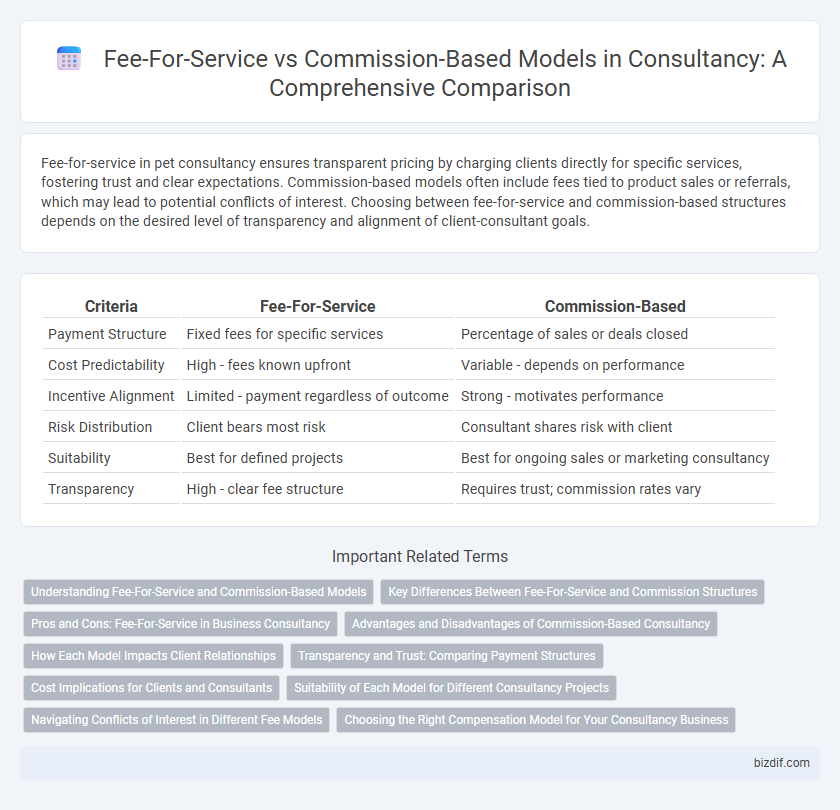Fee-for-service in pet consultancy ensures transparent pricing by charging clients directly for specific services, fostering trust and clear expectations. Commission-based models often include fees tied to product sales or referrals, which may lead to potential conflicts of interest. Choosing between fee-for-service and commission-based structures depends on the desired level of transparency and alignment of client-consultant goals.
Table of Comparison
| Criteria | Fee-For-Service | Commission-Based |
|---|---|---|
| Payment Structure | Fixed fees for specific services | Percentage of sales or deals closed |
| Cost Predictability | High - fees known upfront | Variable - depends on performance |
| Incentive Alignment | Limited - payment regardless of outcome | Strong - motivates performance |
| Risk Distribution | Client bears most risk | Consultant shares risk with client |
| Suitability | Best for defined projects | Best for ongoing sales or marketing consultancy |
| Transparency | High - clear fee structure | Requires trust; commission rates vary |
Understanding Fee-For-Service and Commission-Based Models
Fee-for-service consultancy models charge clients based on specific services delivered, allowing transparent cost structures and tailored project scopes. Commission-based models incentivize consultants through a percentage of sales or savings generated, aligning earnings with client success. Choosing between these models depends on project goals, risk tolerance, and desired financial alignment.
Key Differences Between Fee-For-Service and Commission Structures
Fee-for-service models charge clients a fixed amount for specific consulting tasks, ensuring transparent, predictable costs based on deliverables. Commission-based structures compensate consultants through a percentage of the revenue or savings generated, aligning incentives with client success but potentially causing cost variability. Understanding these differences is crucial for selecting the appropriate model based on project scope, risk tolerance, and client goals.
Pros and Cons: Fee-For-Service in Business Consultancy
Fee-for-service in business consultancy offers transparent pricing and aligns costs directly with delivered services, enhancing budget predictability for clients. This model encourages consultants to provide focused, high-value expertise without the influence of sales volume, but it may limit ongoing incentives for extended client engagement. However, clients benefit from clear accountability and the ability to select specific services without hidden commissions or conflicts of interest.
Advantages and Disadvantages of Commission-Based Consultancy
Commission-based consultancy offers incentives aligned with client success, promoting performance-driven advice and fostering long-term partnerships. However, this model may introduce potential conflicts of interest, as consultants could prioritize higher commissions over unbiased recommendations, impacting client trust. The variable nature of income can also create financial instability for consultants compared to fixed fee-for-service arrangements.
How Each Model Impacts Client Relationships
Fee-for-service models promote transparency and trust by clearly outlining costs, fostering straightforward client expectations and stronger long-term relationships. Commission-based models can create potential conflicts of interest, as consultants may prioritize sales or deals that yield higher commissions over clients' best needs. Understanding these dynamics helps clients choose consultancy arrangements that align with their priorities for fairness and value.
Transparency and Trust: Comparing Payment Structures
Fee-for-service models provide clear, itemized billing that enhances transparency and fosters client trust by detailing exact services rendered. Commission-based payment structures may introduce conflicts of interest, reducing trust as fees depend on sales outcomes rather than service value. Transparent fee-for-service arrangements support stronger client-consultant relationships through predictable, accountable payments.
Cost Implications for Clients and Consultants
Fee-for-service models provide clients with transparent, predictable costs based on specific deliverables, allowing precise budgeting and minimizing the risk of unexpected expenses. Commission-based consultancy often ties consultant compensation to sales or project outcomes, potentially incentivizing higher performance but increasing cost variability and financial risk for clients. Consultants favor fee-for-service for steady income and clear scope definition, while commission-based approaches may lead to higher earnings aligned with value delivered but less income certainty.
Suitability of Each Model for Different Consultancy Projects
Fee-for-service models offer transparency and predictability, making them ideal for projects with clearly defined scopes and deliverables such as strategy development or process optimization. Commission-based models align consultant incentives with client outcomes, suited for sales-driven or performance-based projects where measurable results like revenue growth or market expansion are critical. Selecting the appropriate model depends on project complexity, risk tolerance, and the desired alignment between consultant compensation and project success metrics.
Navigating Conflicts of Interest in Different Fee Models
Fee-for-service models prioritize transparent client billing by charging fixed rates for specific tasks, reducing conflicts of interest by aligning incentives with service delivery rather than outcomes. Commission-based models risk conflicts as consultants may favor solutions that yield higher commissions, potentially compromising unbiased advice. Effective navigation requires stringent disclosure practices and ethical guidelines tailored to each fee structure to maintain client trust and integrity in consultancy engagements.
Choosing the Right Compensation Model for Your Consultancy Business
Selecting the optimal compensation model for your consultancy business hinges on aligning client expectations and service value with financial goals. Fee-for-service offers predictable revenue through fixed rates for defined tasks, fostering transparency and budget control. Commission-based models incentivize performance and revenue growth but introduce variability, making them suitable when client outcomes directly influence consultant earnings.
Fee-For-Service vs Commission-Based Infographic

 bizdif.com
bizdif.com